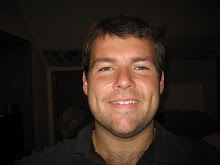
My name is Derrick Antoniak, and this is my blog about being a first-year medical student.
I feel like so many interesting things have happened since my last post, so I will list as many as possible and do none of them justice.
So our dissecting group really has become pretty close. We sit for hours at a time picking fat and connective tissue from a cadaver we call Bootstrap, and I guess that experience, along with the solidarity that comes from going through a difficult life experience together has really put us in what Seinfeld referred to as the 'relationship time machine'. In the five weeks we've known each other, we've shared some good healthy laughs, some dry heaves, occasional tears, and covered the entire spectrum from the lightest to the heaviest moments. About two weeks ago Kylee told Tony and I that she was glad we were a group. The silence that followed prompted some laughter and teasing, but, in reality, I know that we get along well and genuinely care for each other, and I enjoy coming to lab to work with them every day.
Meanwhile, back in the real world, we had an exam coming up. The timeline went as follows: Luke and Janel's wedding was the Saturday before, and it was a blast. It's strange to be a full-blown adult, but I have some great friends that I know will be a part of my life forever, and for the short time I was at the wedding, we rocked it out pretty good. The next morning I got up and ran the corporate cup 10K with Joanna (and by with I mean far, far behind), had lunch at Amarillo, and then went to the gross lab to meet with Kylee and Tony for a review session that was too annoying to finish with my lost voice from the wedding. By Monday, my lost voice had turned into a cold, and its timing could not have been better with the exam looming. I finished the week out strong, though, opting to study most of Friday evening instead of attending the debate-watching party at Joanna's work. I woke up early on Saturday, ready to dominate. Unfortunately, Binhammer and company had different plans for me in the form of an essay question that completely caught me off guard and most likely reduced my exam score significantly. I left the lecture hall knowing that I had passed the exam, but knowing that I hadn't done as well as I wanted to.
As I was walking to my car, though, I was thinking about all the times I had heard the term 'head and neck', not only these past three weeks, but also the dreadful anticipation of 'head and neck' during orientation and the first two weeks of class, and also from the M1's and M2's I had talked to in my interviews both in 2007 and 2006. Dr. Binhammer told us of the many people around campus that say if you can pass 'head and neck', you've got your MD. I can even remember as early as 2005 my biochem professor at UNO telling me about this rite of passage in med school called head and neck.
So I left there not wanting to let that moment pass me by lightly. I had completed the unit, taken the exam, and in all likelihood passed it, and I had sort of the same feeling that I described after the white-coat ceremony, like 'I'm here, I'm really doing this thing that I looked forward to for so long'. So to celebrate, Joanna and I walked door-to-door handing out republican party voter information (slightly less intense than the liter-chugging-contest my classmates opted for at the Crescent Moon, but as anyone who heard Michelle's 'Heads Carolina, Tails California' speech would appreciate, I just wanted to be with her wherever we were).



